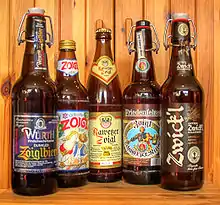Zoigl
Zoigl is a type of beer brewed in the Oberpfalz in north-eastern Bavaria, Germany, between Franconia and the Czech Republic.

The name is believed to be derived from a Windischeschenbacher dialect pronunciation of the German word zeigen or Zeichen meaning "sign", the symbol used to advertise that the beer is available at an establishment. Its two component triangles represent the joining of six beer ingredients: the first triangle denoting water, fire and air; the second and inverted triangle denoting malted barley, hops, water.[1][nb 1]
History
.jpg.webp)
The first documented example of the word "zeigl" occurs in a 1508 document at Neustadt an der Waldnaab, having derived from the German "Zeichen" meaning sign, or "zeigen" meaning show. It was pronounced "zeigel" in the Oberpfalz region. Today the word "Zoigl" is still in use and has given its name to this style of beer production.[2]
Zoigl has been brewed for centuries in communal breweries, owned either by the town or by an association of homebrewers. Zoigl was only found in Windischeschenbach and Neuhaus until about 2000. The name and mark have been pilfered because they were not copyright protected. Hence, the over-advertising of Zoigl beer across Germany. The original comes from Windischeschenbach and Neuhaus, and people have their favorites, because each brewer has his/her own recipes.
Process
First wood is chopped, the fire started to cook the water and barley to temp, it is cooled over copper, then the wort is distributed to the brewers' private cellars, where the fermentation takes place. The method used is bottom fermenting yeast and lagering. About two weeks later the beer is brought to these home pubs where it is tapped directly from the lagering tank. It is then sold in the brewer's house, which effectively becomes a pub until all the beer has been drunk. The pub that has Zoigl from that Friday through Monday then attaches the Zoigl-Star to the corner of his house to show he has beer available. Only about 9 or 10 people have “das Braurecht" in Windischeschenbach at one time.[2]
Notes
- The function of yeast had not yet been discovered in the Middle Ages, and it was considered a byproduct of fermentation, known as "stuff" ("Zeug" in German) to be discarded.[1]
References
- "Zoiglbier". germanbeerinstitute.com. Archived from the original on 2016-03-04. Retrieved 11 October 2016.
- "Zoigl-History - What is Zoigl?". zoigl.de. Retrieved 11 October 2016.
External links
| Look up zoigl star in Wiktionary, the free dictionary. |